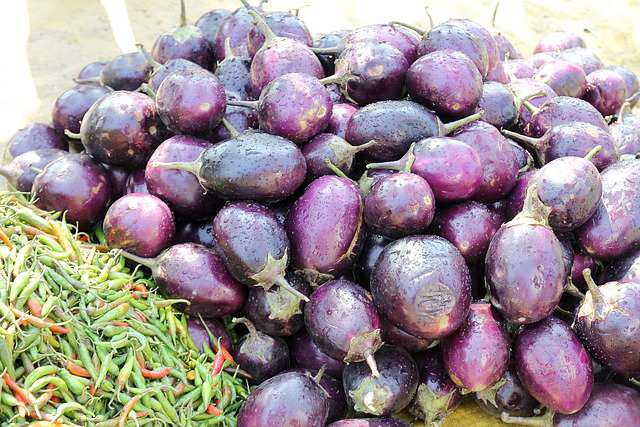Scientifically brinjal is called Solanum melongena and is belongs to the Solanaceae family. Brinjal has different names in India such as baingan in Handi, waangum in Kashmiri, begun in Bengali etc., and there are various brinjal varieties cultivated in India on thousands of hectors of land.
Brinjal can thrive in diverse soil types. Well-drained fertile sandy loam soil is ideal, especially for a long-duration crop like Brinjal. Light soils work well for early crops, while clay loam and silt loam are preferable for high yields. Maintaining a soil pH between 5.5 to 6.6 fosters good growth.
The major Brinjal cultivating states in India include West Bengal, Orissa, Karnataka, Bihar, Maharashtra, Uttar Pradesh, and Andhra Pradesh.

Different Types of Brinjal Varieties Cultivated in India
Brinjal crop’s ability to grow well, adapt to various conditions, and be easily accessible positions it as an affordable choice for many.
Pusa Purple Long
The stems and leaves of Pusa Pirple Long have a purple pigmentation. The fruits grow in clusters of 4-9 and are 10-12 cm long. This type of brinjal is resistant to bacterial wilt.
Harvesting begins around 60-65 days after transplanting, yielding an average of 250 quintals per hectare. The brinjal variety is commonly cultivated in Punjab, Uttar Pradesh, and Delhi.
Arka Neelkanth
This brinjal variety was developed at IIHR in Bangalore, these plants are tall and compact. The fruits are short, displaying a glossy violet-blue skin and a green-purple calyx. The flesh is tender, with slow-maturing seeds and is devoid of bitterness.
On average, each fruit weighs approximately 40g and is clustered in two sets. This particular variety exhibits strong resistance to bacterial wilt and possesses excellent cooking and keeping qualities.
Over a crop duration of 150 days, it yields an impressive 40 tonnes per hectare.
Azad Kranti
Chandra Shekhar Azad University of Agriculture Kanpur, UP develop Azad Kranti brinjal variety. The fruits are oblong, dark purple, and about 15-20cm long. The plants are semi-erect, spreading 60-70 cm, with green leaves and early fruiting.
The fruits are bold, bright purple, round, and about 190-200g. They retain their purple color for a long time and have a good shelf life. The average yield is 45 tonnes per hectare, and it’s less susceptible to shoot and fruit borer infestation.
Pusa Purple Cluster
Pusa Purple Cluster variety was introduced by IARI in New Delhi, is an early maturing variety with small, dark purple fruits grouped in clusters of 2-3. These fruits are a deep purple hue, medium-sized, and slightly shorter than the Pusa Purple Long variety.
You can start picking the crop just 75 days after transplanting. The brinjal variety shows resilience to little leaf disease in natural conditions.
Also Read: Brinjal Crop Diseases and Their Management
Arka Sheel
Arka Sheel is one of the brinjal varieties cultivated in India, this variety boasts elongated, oval fruits, typically measuring 16-18 cm in length. The plant exhibits a semi-erect growth pattern. In terms of yield, it can produce an average of 40-45 tonnes per hectare.
The fruits mature for harvesting within 65-70 days after plantation. This variety shows notable resistance to common brinjal diseases.
Arka Nidhi (BWR-12)
Fruits of Arka Nidhi (BWR 12) born in clusters, the variety was released by IIHR in Bangalore. The leaves are dark green with a purple leaf base and veins when young.
The stem is deep purple green. The fruits are free from bitterness, with slow seed maturity and good cooking quality. The crop is ready to harvesting in 150 days, with an average yield of 48 tonnes per hectare. It’s a high-yielding variety resistant to bacterial wilt.
Pusa Barsati
Pusa Barsati, introduced by Punjab Agricultural University Ludhiana, is a compact plant without thorns. The fruits are medium-sized, long, and purple. The average yield is about 35.5 t/ha. It takes around 65 days from transplanting to the first harvest.
The plants are small and upright without thorns. The fruits are a medium to long size and have a shiny purple appearance. This variety shows better resistance to fruit borers.
Arka Navneet brinjal variety is introduced by Indian Institute of Horticultural Research (IIHR) Bangalore. The veriety is a high-yield hybrid. The fruits are sizeable, oval to oblong, with a deep purple shiny skin, weighing about 450g each.
The crop is ready to be picked in 150-160 days, offering an average yield of 65-70 t/ha.
Arka Kusmukar
Arka Kusmukar is a natural selection from Indian Institute Horticultural Research HR-193, a local plant found in Karnataka. The fruits are small, green, and cluster-borne. The plant has a spreading growth pattern, with green stems and leaves.
The flowers are white, and the small fruits grow in clusters. The texture is soft, making it suitable for cooking. It’s ready for harvest in 140-150 days, with an average yield of 40 t/ha.
Pusa Uttam
This brinjal variety features round to oval-shaped fruits, typically measuring 15-18 cm in size. The plant displays a compact, erect growth pattern. With a commendable yield potential, it can produce around 35-40 tonnes per hectare.
The fruits are ready for harvesting within approximately 70-75 days after plantation. Pusa Uttam exhibits good resistance against prevalent brinjal diseases.
Conclusion
Brinjal, a common tropical vegetable in India, goes by various regional names like Begun (Bengali), baingan (Hindi), and more. India cultivates a diverse range of brinjal cultivars, varying in fruit size, shape, and color. The young fruits are a key ingredient in curries and various dishes.
Brinjal fruits offer moderate levels of essential vitamins and minerals such as phosphorus, calcium, and iron, though nutritional content may differ across cultivars.
Brinjal, a warm-season crop, thrives in extended warm growing periods and is highly sensitive to frost. The best temperature range for successful production is 13-21 C. Growth is significantly hampered if temperatures drop below 17 C. Brinjal is suitable for cultivation during the rainy and summer seasons.



